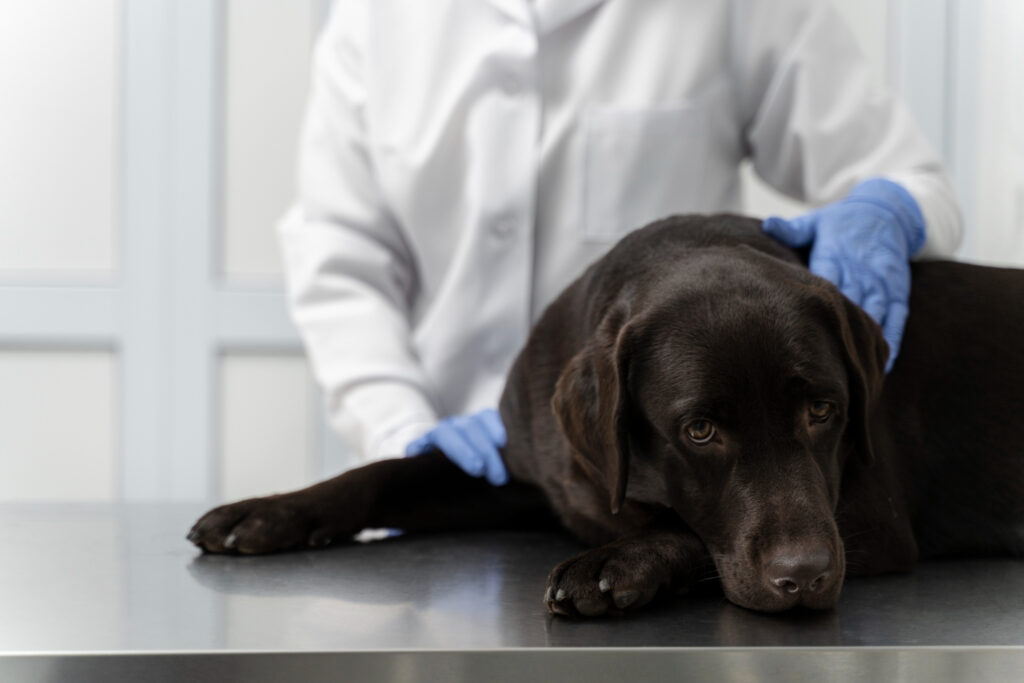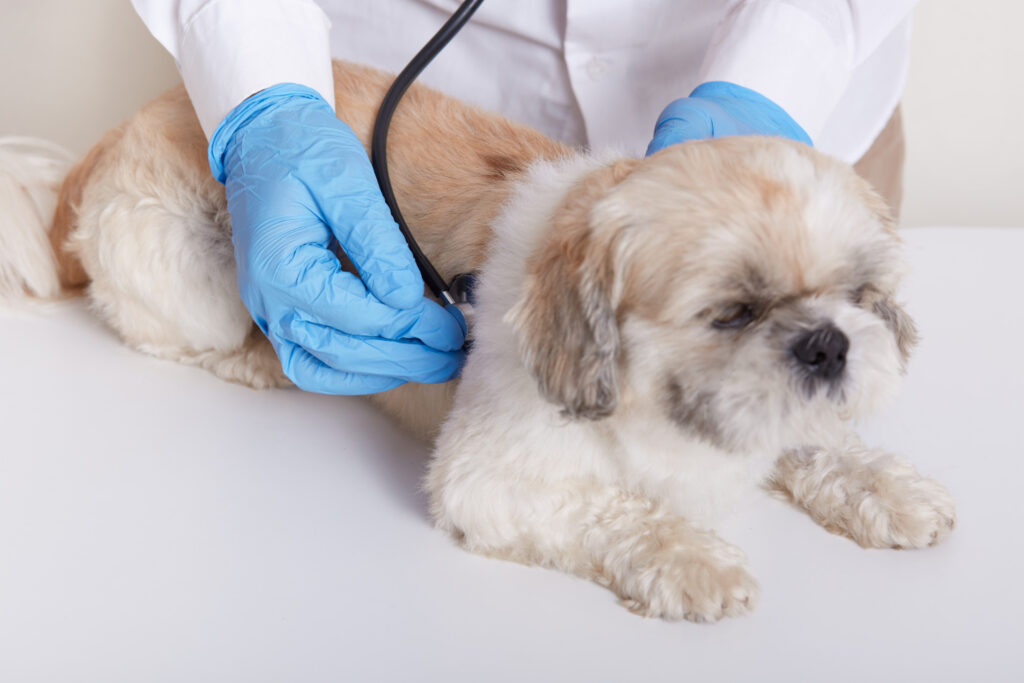As a dog owner, you want to ensure your furry friend stays healthy and happy. One concerning symptom that may cause you to worry is finding blood in your dog stool. Bloody stool, also known as hematochezia, is a common symptom that can indicate a range of health issues. In this article, we’ll discuss the causes, symptoms, and treatment options for blood in dog stool.
Understanding dog stool

As a dog parent, it’s essential to keep an eye on your pet’s stool as it can give you insights into their health.
What is normal dog stool?
Normal dog stool should be well-formed, moist, and relatively easy to pass. The color can vary depending on the dog’s diet and health, but it should generally be a shade of brown. Any significant changes in stool color, consistency, or frequency may indicate an underlying health problem, so it’s important to pay attention to your dog’s bowel movements.
How often should a dog defecate?
In terms of how often a dog should defecate, it can vary based on a number of factors, such as age, diet, and activity level. Generally speaking, most dogs defecate 1-3 times per day. However, some dogs may go more or less frequently and still be within the normal range. If your dog is constantly straining to defecate, has diarrhea or constipation, or has significant changes in frequency, it’s important to consult with your veterinarian.
Factors that can affect stool quality
There are many factors that can affect stool quality. Some common ones include diet, hydration level, exercise, stress, and underlying health conditions. For example, a dog on a low-quality diet or one that is not getting enough water may have dry, hard stools, while a dog with a gastrointestinal issue may have loose, watery stools. Stress and anxiety can also affect stool quality, as they can lead to digestive upset.
Finally, keeping an eye on your dog’s stool and ensuring they have a healthy diet and lifestyle can help promote optimal bowel health.
What is blood in dog poop meaning?
Blood in dog stool can be a concerning symptom, as it may indicate an underlying health problem. The presence of blood in the stool can range from a small amount to a more significant amount, and can have various causes.
What does blood in dog stool look like?
Blood in a dog’s stool can vary in appearance depending on where it’s coming from and how long it’s been in the digestive system. Fresh blood will appear bright red and may be streaked in the stool or appear as small spots. On the other hand, digested blood may appear darker, almost black, and have a tarry consistency. This indicates that the blood has been in the digestive system for a longer period of time and may be coming from higher up in the gastrointestinal tract.
Different types of blood in dog stool
There are different types of blood in dog stool, including:
Hematochezia
This refers to fresh blood in the stool and is often caused by lower gastrointestinal tract issues, such as inflammation or infection in the colon or rectum.
Melena
Melena in dogs refers to digested blood in the stool and can indicate bleeding in the upper gastrointestinal tract, such as the stomach or small intestine. Melena is often a sign of a more serious health problem and should be addressed immediately.
When it comes to color, any bright red blood in the stool is cause for concern and should be checked out by a veterinarian as soon as possible. This indicates active bleeding and could be a sign of a serious health issue, such as gastrointestinal inflammation, infection, or cancer. Dark, tarry stools (melena) are also an emergency and should be addressed immediately. If you notice any changes in your dog’s stool or suspect there may be blood present, it’s important to seek veterinary care right away to ensure prompt treatment and the best possible outcome for your furry friend.
What color indicates an emergency?
When it comes to color, any bright red blood in the stool is cause for concern and should be checked out by a veterinarian as soon as possible. This indicates active bleeding and could be a sign of a serious health issue, such as gastrointestinal inflammation, infection, or cancer. Dark, tarry stools (melena) are also an emergency and should be addressed immediately. If you notice any changes in your dog’s stool or suspect there may be blood present, it’s important to seek veterinary care right away to ensure prompt treatment and the best possible outcome for your furry friend.
Blood in stool dog causes

You should know some reasons that cause your dog pooping blood to have a certain treatment and prevent it timely
Causes of bright red blood in dog stool
Bright red blood in dog stool can be a concerning symptom for pet owners, and there can be several possible causes for this issue. Here are some of the most common causes of bright red blood in dog stool:
Colitis
Inflammation of the colon can cause bleeding, resulting in bright red blood in the stool. Colitis can be caused by dietary changes, infections, or other underlying medical conditions.
Parasites
Hookworms are one of the most common parasites that can cause bloody stools in dogs. These parasites attach to the lining of the intestinal tract, causing bleeding and inflammation.
Trauma
Trauma to the rectum or anus, such as from straining during defecation or due to an injury, can cause bright red blood in the stool.
Toxins
Ingestion of toxins or harmful substances can cause gastrointestinal inflammation, leading to bloody stools.
Inflammatory bowel disease
Inflammatory bowel disease is a chronic condition that causes inflammation of the intestinal tract, leading to symptoms such as diarrhea, vomiting, and bloody stools.
Anal sac infections or impactions
Anal sacs are small glands located near the anus that can become infected or impacted, causing inflammation and bleeding.
If you notice bright red blood in your dog’s stool, it’s important to seek veterinary care to determine the underlying cause and appropriate treatment plan.
Causes of dark or tarry blood in dog stool
Dark or tarry blood in a dog’s stool can indicate a more serious condition than bright red blood, and it is important to seek veterinary attention as soon as possible. Here are some of the potential causes of dark or tarry blood in a dog’s stool:
Parasites
Parasites such as hookworms or whipworms can cause irritation and inflammation in the gastrointestinal tract, leading to dark or tarry stools.
Inflammatory disorders
Inflammatory bowel disease (IBD) or colitis can cause chronic inflammation in the gastrointestinal tract, leading to dark or tarry stools.
Infections
Bacterial or viral infections in the gastrointestinal tract can cause dark or tarry stools, along with other symptoms such as vomiting and diarrhea.
Ulcers
Ulcers in the stomach or intestines can cause dark or tarry stools, as well as vomiting and abdominal pain.
Tumors
Tumors in the gastrointestinal tract, such as colon cancer or intestinal lymphoma, can cause dark or tarry stools.
Foreign bodies and trauma
Ingesting foreign objects or experiencing trauma to the gastrointestinal tract can cause dark or tarry stools.
Kidney failure
Kidney failure can cause dark or tarry stools due to the buildup of toxins in the bloodstream.
Exposure to toxins
Exposure to certain toxins, such as rat poison, can cause dark or tarry stools.
Addison’s disease
Addison’s disease, which affects the adrenal glands, can cause dark or tarry stools as well as vomiting, diarrhea, and lethargy.
Liver disease
Liver disease can cause dark or tarry stools due to the buildup of bilirubin in the bloodstream.
Pancreatitis
Pancreatitis, inflammation of the pancreas, can cause dark or tarry stools as well as vomiting, abdominal pain, and lethargy.
Hormonal imbalances
Hormonal imbalances such as Cushing’s disease can cause dark or tarry stools as well as other symptoms such as increased thirst and appetite.
Clotting disorders
Blood clotting disorders can cause dark or tarry stools due to abnormal bleeding in the gastrointestinal tract.
Reaction to certain medications
Certain medications, such as anti-inflammatory drugs, can cause dark or tarry stools as a side effect.
It is important to seek veterinary attention if you notice dark or tarry blood in your dog’s stool, as this can indicate a serious underlying condition that requires prompt diagnosis and treatment.
Blood in dog stool but acting normal
If your dog has blood in their stool but is acting normally otherwise, it’s still important to take them to the vet for an evaluation. While your dog may not be showing any other symptoms, blood in the stool could be a sign of an underlying health issue that needs attention.
The vet will perform a physical exam and may recommend additional tests like a fecal exam, blood work, or imaging studies. Depending on the underlying cause of the blood in the stool, treatment options may include medication, dietary changes, or surgery.
In some cases, the blood may be caused by a relatively minor issue like an irritation in the digestive tract. However, there is also the possibility that the blood could be a symptom of a more serious condition like cancer or inflammatory bowel disease (IBD).
It’s always better to err on the side of caution when it comes to your pet’s health. Even if your dog seems fine otherwise, a visit to the vet can help ensure that any underlying health issues are caught and treated early, improving your dog’s prognosis and overall quality of life.
Symptoms of blood in dog stool

Blood in a dog’s stool is a concerning symptom that can indicate a variety of health problems. Here are some common symptoms of blood in dog stool:
Visible blood in stool
This may appear as bright red blood or as dark, tarry stools.
Dog poop like jelly with blood
If your dog’s poop looks like jelly and is streaked with blood, it could be a sign of colitis, which is inflammation of the large intestine. Colitis can be caused by a variety of factors, including infections, parasites, and dietary intolerances.
Change in stool consistency or frequency
If your dog’s stool is consistently soft, watery, or mucous-covered, or if they are having more frequent bowel movements than usual, it may be a sign of an underlying health issue.
Bloody diarrhea in dogs
Bloody diarrhea in dogs is a concerning symptom that can indicate a variety of health problems. It can be a sign of a serious health issue like parvovirus or a gastrointestinal infection.
Other potential causes of bloody diarrhea in dogs include infections, parasites, and dietary issues. Even if your dog has bloody diarrhea but acting normal, it’s important to take them to the vet for an evaluation if you notice bloody diarrhea.
Dog pooping blood and vomiting
If your dog is pooping blood and vomiting, it’s important to take them to the vet immediately for an evaluation. These symptoms can be a sign of a serious health problem, such as an obstruction in the digestive tract, a gastrointestinal infection, or a bleeding disorder. Other potential causes of blood in the stool and vomiting include dietary intolerances, parasites, or inflammatory bowel disease.
Bloody mucus in dog stool
When you find bloody mucus in your dog stool, it could be a sign of a number of health problems, such as an infection, parasites, or inflammatory bowel disease. These conditions can also cause diarrhea, vomiting, loss of appetite, and weight loss, among other things.
Signs of discomfort or pain
Your dog may show signs of discomfort or pain when passing stool, such as straining, whimpering, or vocalizing.
If you notice any of these symptoms in your dog, it’s important to take them to the vet for an evaluation. Your vet can diagnose the underlying cause of the blood in the stool and recommend appropriate treatment to address the issue. Early detection and treatment is key to ensuring your dog’s health and well-being.
Why my dog is pooping blood and throwing up foam?
If your dog is pooping blood and throwing up foam, it may indicate a more serious underlying condition that requires prompt veterinary attention. Here are some potential causes:
- Gastrointestinal inflammation: Inflammation of the gastrointestinal tract, such as colitis or inflammatory bowel disease (IBD), can cause both bloody stools and vomiting.
- Foreign objects: If your dog has ingested a foreign object, such as a toy or bone, it can cause irritation and bleeding in the gastrointestinal tract.
- Infections: Bacterial or viral infections in the gastrointestinal tract can cause both bloody stools and vomiting.
- Pancreatitis: Inflammation of the pancreas can cause both bloody stools and vomiting, along with other symptoms such as abdominal pain and lethargy.
- Poisoning: If your dog has ingested a toxic substance, it can cause both bloody stools and vomiting.
- Gastrointestinal tumors: Tumors in the gastrointestinal tract, such as colon cancer or intestinal lymphoma, can cause both bloody stools and vomiting.
Diagnosis of blood in dog Stool
Diagnosis of blood in dog stool typically involves a combination of the following methods:
Physical examination
A veterinarian will perform a thorough physical examination of the dog, which may include assessing the dog’s overall health, checking for signs of dehydration, and palpating the dog’s abdomen for any abnormalities or discomfort.
Fecal analysis
A fecal analysis will be conducted to check for the presence of parasites or other abnormalities in the dog’s stool. The veterinarian will examine the stool under a microscope and may also send it to a laboratory for further testing.
Blood tests
A complete blood count (CBC) and chemistry panel will be performed to check for any underlying medical conditions or abnormalities that could be causing the blood in the dog’s stool. This may include testing for infections, inflammation, or other conditions that affect the dog’s digestive system.
Imaging tests
In some cases, imaging tests such as X-rays or ultrasound may be recommended to assess the dog’s digestive system and look for any signs of damage or abnormalities. This can help identify the underlying cause of the blood in the dog’s stool and guide treatment.
Generally, a combination of physical examination, fecal analysis, blood tests, and imaging tests can help diagnose the cause of blood in a dog’s stool and guide appropriate treatment. It is important to consult with a veterinarian as soon as possible if you notice blood in your dog’s stool, as this can be a sign of a serious medical condition that requires prompt attention.
Treatment of blood in dog stool
When a dog’s stool contains blood, it could be an indication of an underlying health problem. Treatment options for blood in dog stool typically include addressing the underlying cause, medications and supplements, and surgery. Here is a brief explanation of each of these treatment options:
Addressing the underlying cause
To effectively treat blood in a dog’s stool, it is essential to identify and address the underlying cause. Some common causes of blood in a dog’s stool include parasites, infections, allergies, food sensitivities, inflammatory bowel disease, and cancer. A veterinarian can perform various diagnostic tests, including fecal exams, blood tests, and imaging tests, to help determine the underlying cause of the blood in your dog’s stool.
Medications and supplements
Depending on the underlying cause of the blood in your dog’s stool, your veterinarian may recommend medications or supplements to treat the condition. For example, if your dog has an infection or parasite, antibiotics or antiparasitic medications may be prescribed. If your dog has inflammatory bowel disease, steroids or other anti-inflammatory medications may be recommended. Additionally, supplements such as probiotics or fiber may be suggested to improve digestive health.
Surgery
In some cases, surgery may be necessary to treat blood in a dog’s stool. This is typically reserved for more severe cases, such as when a dog has a tumor or obstruction in their digestive tract. Your veterinarian will discuss the risks and benefits of surgery and whether it is an appropriate treatment option for your dog.
Home remedies and prevention
There are some tips on how to treat blood in stool dog at home to help your dog recover and prevent future episodes of bloody stools.
Here are some of the home remedies and prevention tips for blood in a dog’s stool:
- Change their diet: A diet that’s high in fiber and low in fat can help regulate your dog’s digestive system and prevent inflammation. Consider switching your dog’s food to a high-quality, easily digestible brand that meets their specific nutritional needs.
- Provide plenty of water: Dehydration can lead to constipation, which can cause irritation and bleeding in your dog’s intestinal tract. Make sure your dog has access to clean, fresh water at all times.
- Add probiotics: Probiotics can help restore the balance of healthy bacteria in your dog’s gut, which can improve their digestion and reduce inflammation. You can find probiotic supplements specifically designed for dogs at your local pet store.
- Feed them smaller, more frequent meals: Large meals can put stress on your dog’s digestive system and lead to inflammation and bleeding. Consider feeding your dog smaller meals throughout the day to help them digest their food more easily.
- Avoid giving them table scraps: Human food can be high in fat and other ingredients that can upset your dog’s stomach and lead to inflammation. Stick to a healthy, balanced diet specifically formulated for dogs.
- Monitor their stool: Keep an eye on your dog’s stool to watch for any signs of blood, mucus, or other abnormalities. If you notice any changes, contact your veterinarian immediately.
- Exercise regularly: Regular exercise can help regulate your dog’s digestive system and prevent constipation. Aim for at least 30 minutes of exercise each day, such as a brisk walk or a game of fetch.
While these home remedies and preventive measures can be helpful, it’s important to remember that they are not a substitute for proper veterinary care. If you notice blood in your dog’s stool, contact your veterinarian right away to schedule an appointment and discuss treatment options.
When to seek veterinary care
If you notice blood in your dog’s stool, it can be a cause for concern. Depending on the severity of the symptoms, you may need to seek veterinary care right away, or you may be able to wait until the next available appointment. Here is some information to help you determine when to seek veterinary care for your dog.
When is blood in dog poop an emergency and need to seek veterinary care:
- Bright red blood: If you see bright red blood in your dog’s stool, this may indicate bleeding in the lower intestinal tract. This could be due to various reasons such as colitis, rectal injury, parasites or cancer.
- Large amounts of blood: If you see large amounts of blood in your dog’s stool, this may indicate a more severe issue, such as a hemorrhage. This is an emergency and you should seek veterinary care immediately.
- Lethargy: If your dog appears lethargic, weak, or is vomiting, in addition to having bloody stool, this is an emergency situation that requires immediate veterinary attention.
- Straining: If your dog is straining to defecate and passing small amounts of bloody mucus, this could be a sign of a severe condition such as colitis or inflammatory bowel disease.
How long does blood in dog stool last?
The duration of blood in a dog’s stool can vary depending on the underlying cause. In some cases, it may be a temporary issue that resolves on its own, while in other cases it may require veterinary intervention to resolve.
If the cause is due to something like dietary changes or a minor gastrointestinal upset, the blood in the stool may last only a few days to a week. However, if the cause is due to an infection or parasite, the duration of blood in the stool may last until the underlying issue is properly diagnosed and treated.
FAQs
Can a dog die from pooping blood?
Yes, a dog can potentially die from pooping blood if the underlying cause is left untreated for too long. For example, if the cause is due to a severe hemorrhage or a gastrointestinal obstruction, it can quickly become life-threatening. It’s important to seek veterinary care promptly if you notice blood in your dog’s stool.
Is blood in dog stool always a sign of cancer?
No, blood in a dog’s stool is not always a sign of cancer. While cancer can be a potential cause of bloody stools in dogs, there are many other possible causes, such as infections, parasites, dietary changes, or gastrointestinal inflammation. A proper diagnosis is important to determine the underlying cause.
Can I give my dog human medication for blood in their stool?
No, it is not recommended to give human medication to dogs without consulting with a veterinarian. Medications that are safe for humans can be toxic to dogs or can have different dosages and side effects. It’s important to seek veterinary care and follow their prescribed treatment plan.
Can a dog poop blood from stress?
Yes, stress can cause changes in the body that can affect the digestive system, leading to conditions such as colitis or other forms of gastrointestinal inflammation. This can result in bloody stools. However, it’s important to note that there can be many other potential causes of blood in a dog’s stool, and a proper diagnosis from a veterinarian is necessary to determine the underlying cause.
Conclusion
After all, blood in dog stool can be a concerning symptom for dog owners. While it can sometimes be a temporary issue that resolves on its own, it can also be an indication of a more serious underlying condition that requires veterinary attention. Causes of blood in dog stool can range from minor dietary changes or stress to infections, parasites, and cancer. Early detection and treatment are crucial to preventing potentially life-threatening complications. If you notice blood in your dog’s stool, it is important to seek veterinary care promptly. By addressing the issue early, you can ensure the best possible outcome for your furry companion.

